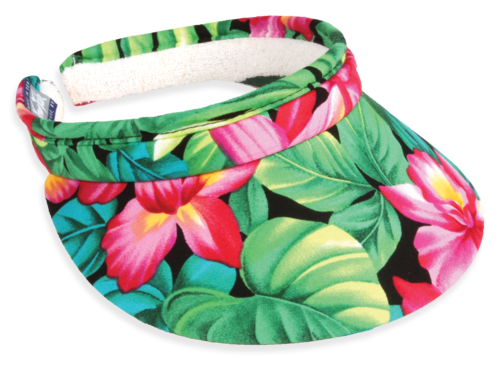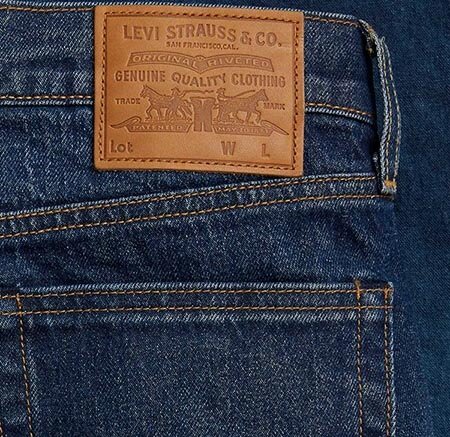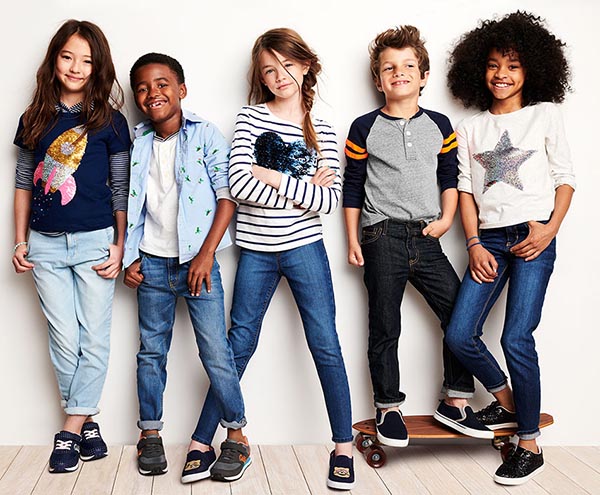These Are America's Oldest Clothing Brands
Shop as if you lived 100 years ago from companies that have been around for more than a century.
By Jessie Schiewe
One-hundred years ago, we dressed differently.
Back then, women’s skirts and dresses touched the floor and all the men wore jackets and ties, even in hot weather. Wool and linen were popular materials, as stretchy, breathable fabrics like nylon and polyester did not yet exist. Zippers didn’t either, so a lot of the clothing was fastened with buttons, hooks, or laces.
Outfits in the U.S. have evolved since then and so, too, have the brands that have been making our clothing. From Levi’s to L. L. Bean, there are a number of clothing companies that are more than a century old and still being worn by people you see everyday.
In fact, you probably have an item from one of these brands hanging in your closet or folded away in a drawer and you don’t even know it.
For those who think that being vintage means wearing only clothing from the past, we’ve got another concept to introduce you to: dressing in new clothing made by super-old companies.
Of course, you won’t look as retro than if you had shopped at a thrift store, but that’s part of the reason why these brands have managed to last for so long. Most of them achieved success by specializing in one particular item, and, over the decades, learned how to adapt it to current trends. Which is no easy feat. The fashion world is mercurial, consumers are fickle, and 100 years is a long time to keep a business going.
From department stores to brick-and-mortar boutiques, malls to online shopping, here are 9 clothing brands that have weathered the decades and made it to the other side.
Town Talk
Since 1917
Formed by Gene Meyer, this family-owned business in Louisville, Kentucky, was originally a full haberdashery, specializing in felt hats.
Town Talk’s specialities have since adapted and changed with the times, and they now mainly sell visors, baseball caps, beanies, and bucket hats.
According to family lore, Town Talk survived the Depression without laying off a single employee because business never declined.
“Back then, you had to have a hat, even if you were unemployed,” Ann Schottler, Meyer’s great-granddaughter, told OK Whatever. She, along with her sister and brother-in-law, still work at the family business.
The newest addition to Town Talk’s catalogue is belts, and you can get pretty much anything from their store embroidered. Their products are no longer 100-percent American-made, but the bulk of the manufacturing is still done in their offices in Kentucky.
Perhaps the coolest thing about Town Talk, though, are their visors. Since the ‘80s they’ve been selling them, sprucing them up with rhinestones, faux leather, and crazy printed patterns of Hawaiian flowers, cheetah spots, and hot chili peppers.
Levi Strauss & Co.
Since 1853
At 166-years-old, Levi Strauss & Co. are responsible, literally, for inventing blue jeans.
Back when corsets and suits were still the norm, Levi Strauss was working on inventing an easy-to-wear pant reinforced with copper rivets for sturdier workwear.
He created the Levi’s 501 jean in 1890, the company’s most popular style that you can still buy today.
Strauss died in 1901, five years before the San Francisco earthquake, during which the Levi Strauss & Co. factory and headquarters were demolished. That, however, didn’t stop the company’s progress, and it continued making innovations throughout the early twentieth century.
In 1912, it released children’s clothing, and by 1920, it had introduced a line of less restrictive, baggy trousers for women known as Freedom Alls. Back when segregation was still legal, Levi’s was one of the first companies to integrate its staff in 1960. Worn by celebrities and even banned in schools in the 1950s, Levi’s remains one of the leading jean brands today.
The company is also forward-thinking and has added an A.I. stylist named Indigo to its online store. You can chat with her and she’ll help you find a pair of jeans that fits your needs or even put together a full outfit.
L.L. Bean
Since 1912
One-hundred-and-five years ago, Leon Leonwood Bean created a boot with leather tops and rubber bottoms. Little did he know that more than a century later, people would still be buying that shoe.
It’s now called the Maine Hunting Boot and sells for around $139.
But the boots Bean invented in 1912 were a far-cry from what they are now. The first 100 pairs he sold through a catalogue fell apart after they were worn. Bean refunded the people who had bought them and then worked to make them even better. By 1921, he had perfected the boots well enough that explorers in the Arctic were wearing the shoe. He then went on to create outdoors equipment, and even gifted a trout knife to President Teddy Roosevelt in the ‘30s.
You can still buy trout knives from L.L. Bean today, along with clothing for the whole family, gear for pretty much every outdoor adventure sport, items for every room in your house, and even chew toys for your dog. They even sell guns, but only for hunting and only at their flagship store in Freeport, Maine which is conveniently open 24 hours a day every day of the year.
Abercrombie & Fitch
Since 1892
What started as an elitist New York clothing brand for the bourgeois outdoorsman has since morphed into every Midwestern teenager’s favorite store in the mall.
For its first 80 or so years, Abercrombie & Fitch sold mainly expensive shotguns, fishing rods, fishing boats, and tents. Teddy Roosevelt bought supplies from it for a safari and Ernest Hemingway was reportedly a frequent customer. At one point in the 1970s, the company had for sale an $18,000 gold and onyx chess set.
Ten years, one bankruptcy, and a few store closures later, and Abercrombie & Fitch emerged in the late 1990s as the preeminent brand for cool and trendy young adults. It started selling heady perfumes and logo-branded T-shirts in stores designed to look like rustic cabins, replete with fake mounted moose heads and ridiculously attractive salespeople whom they referred to as “models.”
The company has changed drastically since then, especially in regards to its ads. They’re still generally black-and-white, but instead of salacious, partially undressed young Anglo men and waif-like women, they now feature more ethnically and physiologically inclusive models, some of whom they found through Instagram.
OshKosh B’gosh
Since 1895
The company got its start in Oshkosh, Wisconsin, hence the first part of its name. The second half of its name is believed to be a combination of the words “by gosh” (or “by God”).
The company originally sold striped overalls for railroad workers and miners. By the 1900s, it expanded its line to include children’s sizes so that kids could dress like their fathers.
OshKosh B’gosh sold products largely through mail order catalogues and department stores, and by 1995 had become almost entirely dedicated to making children’s clothing. It stopped manufacturing men’s clothing soon thereafter.
But OshKosh B’gosh did branch out occasionally. In the 1980s, it dressed an entire line of Cabbage Patch Dolls in branded overalls.
Today, OshKosh B’gosh sells apparel for babies, infants, toddlers, kids (ages 4 to 7), and youths (5 to 14). And yes, their self-described “world’s best overalls” are available for all ages.
Converse All Stars
Since 1908
It’s probably not surprising that Converse shoes are over 100 years old, because let’s be honest: their shoes already look retro.
Despite the decades, their design is pretty much unchanged, and they’re still made of rubber and cotton canvas just like they were back in 1908 when Marquis Mills Converse created them in Malden, Massachusetts.
The modern-day Converse All Star was unveiled in 1917, and the company touted their “non-skid” and “suction” soles through ads in national magazines.
Before Nike, it was Converse that ruled basketball courts, becoming a favorite among athletes, like Charles “Chuck” Taylor who helped popularize the shoe among high school students and improved its form to include more flexibility and support. By the ’30s, Olympic athletes were wearing them to compete, and during World War II, American soldiers wore them during training.
By the ’80s, Converse had lost its grip on the athletic footwear scene, and nowadays, they’re known more for their bright hues and flamboyant patterns more than anything. The brand has even filed for bankruptcy a couple of times, and was swooped up by Nike who purchased the company for $305 million in 2003.
In recent years, Converse has been busy suing companies, like Skechers, for producing knock-offs of their sneakers. But that hasn’t been going so well for them. In 2016, the International Trade Commission ruled that Converse’s design was not entitled to trademark protection — a decision that probably made Chuck Taylor turn in his grave, because, ironically, the announcement was made on the 47th anniversary of his death.
Lee Jeans
Since 1889
Lee has been a household name in jeans for more than 100 years, but when Henry David Lee started the brand in 1889, it spent its first two decades of existence as a grocery distributor.
The switch to apparel happened in 1913 when Lee, upset with the shoddy quality of the jumpsuits his workers were wearing, decided he could make them better.
He was right.
Within two decades, Lee was the number one manufacturer of work clothing in the U.S., responsible for inventing such things as zip-front coveralls and zip-fly jeans. The brand became known not only for its cherubic Buddy Lee mascot doll, but also for its denim, which is strong and durable. Lee started making jeans for women in the ‘70s and by the time the ‘90s rolled around, even Barbie was wearing the brand.
Nowadays, vintage Lee’s are prized commodities among hipsters and wearers of mom jeans. But you don’t have to go thrifting to find a cool pair of them. The company sells a combination of newer styles (straight leg, boot cuts) and more vintage-inspired looks with flared hems, rainbow stripes down the sides, and button-fly closures.
Warner’s
Since 1874
You can find Warner’s products on Amazon and in stores like Target and Kohl’s, but what they’re selling today is far different from what they started out with in 1874.
Back then, the company specialized in corsets made entirely from cloth that had a little give to them because they lacked steel rods. At the time, this was a huge improvement in the comfortability of corsets, which were rigid and notorious for being painful.
The company reportedly made $7 million in sales in 1913.
By the 1930s, Warner’s had transitioned from making corsets to the more fashionable bra. It also created a revolutionary sizing system for bras using letters of the alphabet that is still widely used today.
American Needle
Since 1918
This third generation family business started in Chicago in 1918 as an importer of sewing needles, but started making headwear soon after.
They’re credited as one of the first companies to make baseball team caps for fans, after one of their employees approached the Chicago Cubs in 1946 with the idea of selling hats that looked like the ones the players wore on the field.
Back then, this was a revolutionary idea and some people were dubious about its success. According to American Needle’s website, the team’s owner at the time is believed to have said, “Who would want to buy the hats that the players are wearing?” A lot of people it turned out.
The first batch of Cubs hats sold out in a mere day. The second batch sold out even faster.
Today, American Needle specializes in fan caps for Major League, NFL, and NHL teams, but you can also find their hats — which are available in myriad shapes — at stores like Free People and Nordstrom.





















Workwear as regular clothing is now a thing.